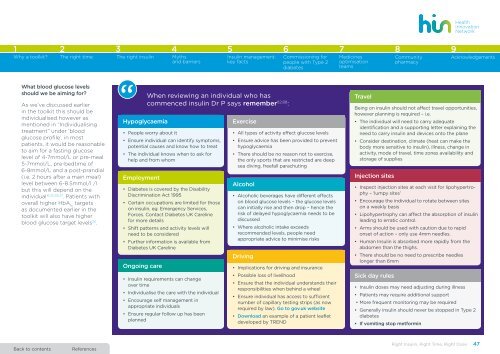1gOgRTa
1gOgRTa
1gOgRTa
You also want an ePaper? Increase the reach of your titles
YUMPU automatically turns print PDFs into web optimized ePapers that Google loves.
1 2 3 4 5 6 7 8Why a toolkit?The right time The right insulin Mythsand barriersInsulin management:key factsCommissioning forpeople with Type 2diabetesMedicinesoptimisationteamsCommunitypharmacy9AcknowledgementsWhat blood glucose levelsshould we be aiming for?As we’ve discussed earlierin the toolkit this should beindividualised however asmentioned in “Individualisingtreatment” under ‘bloodglucose profile’, in mostpatients, it would be reasonableto aim for a fasting glucoselevel of 4-7mmol/L or pre-meal5-7mmol/L, pre-bedtime of6-8mmol/L and a post-prandial(i.e. 2 hours after a main meal)level between 6-8.5mmol/l /lbut this will depend on theindividual 16,20,55,57 . Patients withoverall higher HbA 1ctargetsas documented earlier in thetoolkit will also have higherblood glucose target levels 20 .“HypoglycaemiaWhen reviewing an individual who hascommenced insulin Dr P says remember 82,88 :• People worry about it• Ensure individual can identify symptoms,potential causes and know how to treat• The individual knows when to ask forhelp and from whomEmployment• Diabetes is covered by the DisabilityDiscrimination Act 1995• Certain occupations are limited for thoseon insulin, eg. Emergency Services,Forces. Contact Diabetes UK Carelinefor more details• Shift patterns and activity levels willneed to be considered• Further information is available fromDiabetes UK CarelineOngoing care• Insulin requirements can changeover time• Individualise the care with the individual• Encourage self management inappropriate individuals• Ensure regular follow up has beenplannedExercise• All types of activity effect glucose levels• Ensure advice has been provided to preventhypoglycaemia• There should be no reason not to exercise,the only sports that are restricted are deepsea diving, freefall parachutingAlcohol• Alcoholic beverages have different effectson blood glucose levels – the glucose levelscan initially rise and then drop – hence therisk of delayed hypoglycaemia needs to bediscussed• Where alcoholic intake exceedsrecommended levels, people needappropriate advice to minimise risksDriving• Implications for driving and insurance• Possible loss of livelihood• Ensure that the individual understands theirresponsibilities when behind a wheel• Ensure individual has access to sufficientnumber of capillary testing strips (as nowrequired by law). Go to gov.uk website• Download an example of a patient leafletdeveloped by TRENDTravelBeing on insulin should not affect travel opportunities,however planning is required – i.e.• The individual will need to carry adequateidentification and a supporting letter explaining theneed to carry insulin and devices onto the plane• Consider destination, climate (heat can make thebody more sensitive to insulin), illness, change inactivity, mode of travel, time zones availability andstorage of suppliesInjection sites• Inspect injection sites at each visit for lipohypertrophy– ‘lumpy sites’• Encourage the individual to rotate between siteson a weekly basis• Lipohypertrophy can affect the absorption of insulinleading to erratic control.• Arms should be used with caution due to rapidonset of action – only use 4mm needles.• Human Insulin is absorbed more rapidly from theabdomen than the thighs.• There should be no need to prescribe needleslonger than 6mmSick day rules• Insulin doses may need adjusting during illness• Patients may require additional support• More frequent monitoring may be required• Generally insulin should never be stopped in Type 2diabetes• If vomiting stop metforminBack to contentsReferencesRight Insulin, Right Time, Right Dose 47


